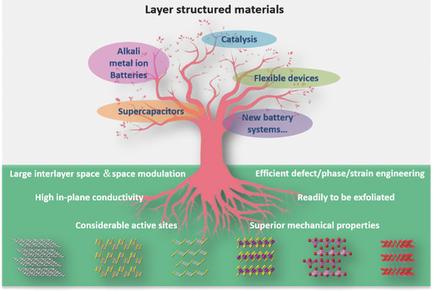Our official English website, www.x-mol.net, welcomes your
feedback! (Note: you will need to create a separate account there.)
Layer Structured Materials for Advanced Energy Storage and Conversion
Small ( IF 13.0 ) Pub Date : 2017-09-13 , DOI: 10.1002/smll.201701649 Yanpeng Guo 1 , Yaqing Wei 1 , Huiqiao Li 1 , Tianyou Zhai 1
Small ( IF 13.0 ) Pub Date : 2017-09-13 , DOI: 10.1002/smll.201701649 Yanpeng Guo 1 , Yaqing Wei 1 , Huiqiao Li 1 , Tianyou Zhai 1
Affiliation

|
Owing to the strong in‐plane chemical bonds and weak van der Waals force between adjacent layers, investigations of layer structured materials have long been the hotspots in energy‐related fields. The intrinsic large interlayer space endows them capabilities of guest ion intercalation, fast ion diffusion, and swift charge transfer along the channels. Meanwhile, the well‐maintained in‐plane integrity contributes to exceptional mechanical properties. This anisotropic structural feature is also conducive to effective chemical combination, exfoliation, or self‐assembly into various nanoarchitectures, accompanied by the introduction of defects, lattice strains, and phase transformation. This review starts with a brief introduction of typical layered materials and their crystal structures, then the structural characteristics and structure oriented unique applications in batteries, capacitors, catalysis, flexible devices, etc., are highlighted. It is surprising to observe that layered materials possess: (1) high reactivity, high reversibility, and enhanced performance via forming additional chemical bonds in alkali‐metal ion batteries; (2) facile phase modulation, great feasibility for in‐plane/sandwich device design, and cation intercalation enabled high capacitance in supercapacitors; (3) promoted structural diversity, effective strain engineering, and capabilities to function as ideal supporting materials/templates in electrocatalysis field. Finally, the future prospects and challenges faced by layered materials are also outlined.
中文翻译:

用于高级能量存储和转换的层状结构材料
由于相邻层之间的强平面化学键和弱的范德华力,层结构材料的研究一直是能源相关领域的热点。固有的大层间空间使它们具有客体离子嵌入,快速离子扩散和沿通道快速电荷转移的功能。同时,保持良好的面内完整性有助于获得出色的机械性能。这种各向异性的结构特征也有利于有效的化学结合,剥离或自组装成各种纳米结构,并伴有缺陷,晶格应变和相变的引入。这篇评论首先简要介绍了典型的分层材料及其晶体结构,然后重点介绍了在电池,电容器,催化,柔性设备等方面的结构特性和面向结构的独特应用。令人惊讶地观察到,层状材料具有:(1)高反应性,高可逆性和通过在碱金属离子电池中形成额外的化学键而增强的性能;(2)容易的相位调制,在平面/三明治式设备设计中具有很大的可行性,并且阳离子嵌入使超级电容器具有高电容;(3)促进了结构的多样性,有效的应变工程以及在电催化领域中充当理想支撑材料/模板的功能。最后,还概述了分层材料面临的未来前景和挑战。令人惊讶地观察到,层状材料具有:(1)高反应性,高可逆性和通过在碱金属离子电池中形成额外的化学键而增强的性能;(2)容易的相位调制,在平面/三明治式设备设计中具有很大的可行性,并且阳离子嵌入使超级电容器具有高电容;(3)促进了结构的多样性,有效的应变工程以及在电催化领域中充当理想支撑材料/模板的功能。最后,还概述了分层材料面临的未来前景和挑战。令人惊讶地观察到,层状材料具有:(1)高反应性,高可逆性和通过在碱金属离子电池中形成额外的化学键而增强的性能;(2)容易的相位调制,在平面/三明治式设备设计中具有很大的可行性,并且阳离子嵌入使超级电容器具有高电容;(3)促进了结构的多样性,有效的应变工程以及在电催化领域中充当理想支撑材料/模板的功能。最后,还概述了分层材料面临的未来前景和挑战。平面/三明治式设备设计的可行性很高,阳离子嵌入可在超级电容器中实现高电容;(3)促进了结构的多样性,有效的应变工程以及在电催化领域中充当理想支撑材料/模板的功能。最后,还概述了分层材料面临的未来前景和挑战。平面/三明治式设备设计的可行性很高,阳离子嵌入可在超级电容器中实现高电容;(3)促进了结构的多样性,有效的应变工程以及在电催化领域中充当理想支撑材料/模板的功能。最后,还概述了分层材料面临的未来前景和挑战。
更新日期:2017-09-13
中文翻译:

用于高级能量存储和转换的层状结构材料
由于相邻层之间的强平面化学键和弱的范德华力,层结构材料的研究一直是能源相关领域的热点。固有的大层间空间使它们具有客体离子嵌入,快速离子扩散和沿通道快速电荷转移的功能。同时,保持良好的面内完整性有助于获得出色的机械性能。这种各向异性的结构特征也有利于有效的化学结合,剥离或自组装成各种纳米结构,并伴有缺陷,晶格应变和相变的引入。这篇评论首先简要介绍了典型的分层材料及其晶体结构,然后重点介绍了在电池,电容器,催化,柔性设备等方面的结构特性和面向结构的独特应用。令人惊讶地观察到,层状材料具有:(1)高反应性,高可逆性和通过在碱金属离子电池中形成额外的化学键而增强的性能;(2)容易的相位调制,在平面/三明治式设备设计中具有很大的可行性,并且阳离子嵌入使超级电容器具有高电容;(3)促进了结构的多样性,有效的应变工程以及在电催化领域中充当理想支撑材料/模板的功能。最后,还概述了分层材料面临的未来前景和挑战。令人惊讶地观察到,层状材料具有:(1)高反应性,高可逆性和通过在碱金属离子电池中形成额外的化学键而增强的性能;(2)容易的相位调制,在平面/三明治式设备设计中具有很大的可行性,并且阳离子嵌入使超级电容器具有高电容;(3)促进了结构的多样性,有效的应变工程以及在电催化领域中充当理想支撑材料/模板的功能。最后,还概述了分层材料面临的未来前景和挑战。令人惊讶地观察到,层状材料具有:(1)高反应性,高可逆性和通过在碱金属离子电池中形成额外的化学键而增强的性能;(2)容易的相位调制,在平面/三明治式设备设计中具有很大的可行性,并且阳离子嵌入使超级电容器具有高电容;(3)促进了结构的多样性,有效的应变工程以及在电催化领域中充当理想支撑材料/模板的功能。最后,还概述了分层材料面临的未来前景和挑战。平面/三明治式设备设计的可行性很高,阳离子嵌入可在超级电容器中实现高电容;(3)促进了结构的多样性,有效的应变工程以及在电催化领域中充当理想支撑材料/模板的功能。最后,还概述了分层材料面临的未来前景和挑战。平面/三明治式设备设计的可行性很高,阳离子嵌入可在超级电容器中实现高电容;(3)促进了结构的多样性,有效的应变工程以及在电催化领域中充当理想支撑材料/模板的功能。最后,还概述了分层材料面临的未来前景和挑战。











































 京公网安备 11010802027423号
京公网安备 11010802027423号